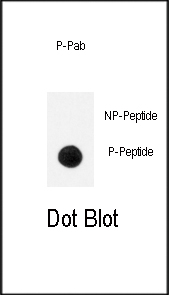产品名称
Phospho-TrkA(Y791) Rabbit Polyclonal Antibody
别名
High affinity nerve growth factor receptor, Neurotrophic tyrosine kinase receptor type 1, TRK1-transforming tyrosine kinase protein, Tropomyosin-related kinase A, Tyrosine kinase receptor, Tyrosine kinase receptor A, Trk-A, gp140trk, p140-TrkA, NTRK1, MTC, TRK, TRKA
存储缓冲液
Purified polyclonal antibody supplied in PBS with 0.09% (W/V) New type preservative N. This antibody is purified through a protein A column, followed by peptide affinity purification.
Human Gene ID
NP_001007793.1;NP_001012331.1;NP_002520.2
Human Swissprot No.
P04629
特异性
This TrkA Antibody is generated from rabbits immunized with a KLH conjugated synthetic phosphopeptide corresponding to amino acid residues surrounding Y791 of human TrkA.
运输及保存条件
Maintain refrigerated at 2-8°C for up to 2 weeks. For long term storage store at -20°C in small aliquots to prevent freeze-thaw cycles.
背景介绍
TrkA is a member of the neurotrophic tyrosine kinase receptor (NTKR) family. This kinase is a membrane-bound receptor that, upon neurotrophin binding, phosphorylates itself and members of the MAPK pathway. The presence of this kinase leads to cell differentiation and may play a role in specifying sensory neuron subtypes. Mutations in the TrkA gene have been associated with congenital insensitivity to pain, anhidrosis, self-mutilating behavior, mental retardation and cancer.
组织表达
Isoform TrkA-I is found in most non-neuronal tissues. Isoform TrkA-II is primarily expressed in neuronal cells TrkA-III is specifically expressed by pluripotent neural stem and neural crest progenitors.
细胞定位
Cell membrane; Single-pass type I membrane protein. Early endosome membrane {ECO:0000250|UniProtKB:P35739}; Single-pass type I membrane protein {ECO:0000250|UniProtKB:P35739}. Late endosome membrane {ECO:0000250|UniProtKB:P35739}; Single-pass type I membrane protein {ECO:0000250|UniProtKB:P35739}. Recycling endosome membrane {ECO:0000250|UniProtKB:P35739}; Single-pass type I membrane protein {ECO:0000250|UniProtKB:P35739}. Note=Rapidly internalized after NGF binding (PubMed:1281417). Internalized to endosomes upon binding of NGF or NTF3 and further transported to the cell body via a retrograde axonal transport. Localized at cell membrane and early endosomes before nerve growth factor (NGF) stimulation. Recruited to late endosomes after NGF stimulation. Colocalized with RAPGEF2 at late endosomes {ECO:0000250|UniProtKB:P35739, ECO:0000269|PubMed:1281417}
功能
Receptor tyrosine kinase involved in the development and the maturation of the central and peripheral nervous systems through regulation of proliferation, differentiation and survival of sympathetic and nervous neurons. High affinity receptor for NGF which is its primary ligand (PubMed:
1850821, PubMed:
1849459, PubMed:
1281417, PubMed:
8325889, PubMed:
15488758, PubMed:
22649032, PubMed:
17196528, PubMed:
27445338). Can also bind and be activated by NTF3/neurotrophin- 3. However, NTF3 only supports axonal extension through NTRK1 but has no effect on neuron survival (By similarity). Upon dimeric NGF ligand- binding, undergoes homodimerization, autophosphorylation and activation (PubMed:
1281417). Recruits, phosphorylates and/or activates several downstream effectors including SHC1, FRS2, SH2B1, SH2B2 and PLCG1 that regulate distinct overlapping signaling cascades driving cell survival and differentiation. Through SHC1 and FRS2 activates a GRB2-Ras-MAPK cascade that regulates cell differentiation and survival. Through PLCG1 controls NF-Kappa-B activation and the transcription of genes involved in cell survival. Through SHC1 and SH2B1 controls a Ras-PI3 kinase-AKT1 signaling cascade that is also regulating survival. In absence of ligand and activation, may promote cell death, making the survival of neurons dependent on trophic factors.

